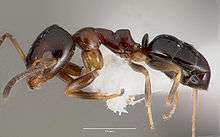Ochetellus glaber
| Ochetellus glaber | |
|---|---|
 | |
| Ochetellus glaber worker | |
| Scientific classification | |
| Kingdom: | Animalia |
| Phylum: | Arthropoda |
| Class: | Insecta |
| Order: | Hymenoptera |
| Family: | Formicidae |
| Subfamily: | Dolichoderinae |
| Genus: | Ochetellus |
| Species: | O. glaber |
| Binomial name | |
| Ochetellus glaber (Mayr, 1862) | |
| Subspecies | |
| |
| Synonyms | |
| |
Ochetellus glaber (black house ant) is a species of ant. The species are found in both urban and rural areas in Australia, and usually nest under stones or dry logs. The species can commonly be found in gardens.[1] The adult ants usually grow to 2.5 mm to 3 mm long.
Taxonomy
Ochetellus glaber was originally described as Hypoclinea glabra by Austrian entomologist Gustav Mayr in a 1862 article, "Myrmecologische Studien", published in the Verhandlungen der Zoologisch-Botanischen Gesellschaft in Wien.[2] The ant was described from syntype workers and males Mayr collected from Sydney in Australia, now preserved in the Natural History Museum in London. Its placement in Hypoclinea was short lived, as Mayr transferred it to the genus Iridomyrmex as Iridomyrmex glaber in 1865.[3] Its placement in Iridomyrmex was accepted for more than a century, until entomologist Steve Shattuck revised the genus in 1992 and transferred the ant into a new genus, Ochetellus.[4] He also designated O. glaber as the type species of the genus.
O. glaber has two synonyms, Iridomyrmex itoi and Iridomyrmex itoi abbotti. I. itoi was described as a separate species, while I. itoi abbotti was recognised as a subspecies.[5][6] The subspecies was shortlived and was synonymised with I. itoi in 1910, and in the 1950s I. itoi was first noted to be similar to O. glaber.[7][8] Despite the similarities, I. itoi remained a valid species until a 1995 publication confirmed its synonymy with O. glaber.[9] Today, there are currently three subspecies: O. glaber clarithorax,[10] O.glaber consimilis[11] and O. glaber sommeri.[10] It is commonly known as the Black house ant or the Tramp ant.[12][13]
Description
O. glaber is a small species of ant, with workers measuring 2–3 mm (0.079–0.118 in).[2][13] Males are the smallest at 1.6 millimetres (0.063 in) and queens are the largest at 5.2–5.5 millimetres (0.20–0.22 in).[2][14]
References
- ↑ "Ochetellus glaber (Mayr)". Land Care Research. Retrieved 2009-12-21.
- 1 2 3 Mayr, G. (1862). "Myrmecologische Studien" (PDF). Verhandlungen der Zoologisch-Botanischen Gesellschaft in Wien. 12: 649–776. doi:10.5281/zenodo.25912.
- ↑ Mayr, G. (1865). Formicidae. In: Novara Expedition 1865 Reise der Oesterreichischen Fregatte Novara um die Erde in den Jahren 1857, 1858, 1859, unter den befehlen des Commodore B. von Wuellerstorf-Urbair. Zoologischer Theil. Formicidae (PDF). Vienna: K. Gerold's Sohn. p. 61.
- ↑ Shattuck, S.O. (1992). "Review of the dolichoderine ant genus Iridomyrmex Mayr with descriptions of three new genera (Hymenoptera: Formicidae)". Australian Journal of Entomology. 31 (1): 13–18. doi:10.1111/j.1440-6055.1992.tb00453.x.
- ↑ Forel, A. (1900). "Fourmis du Japon. Nids en toile. Strongylognathus Huberi et voisins. Fourmilière triple. Cyphomyrmex Wheeleri. Fourmis importées" (PDF). Mitteilungen der Schweizerischen Entomologischen Gesellschaft. 10: 267–287. doi:10.5281/ZENODO.14386.
- ↑ Wheeler, W.M. (1906). "The ants of Japan" (PDF). Bulletin of the American Museum of Natural History. 22: 301–328.
- ↑ Yano, M. (1910). "[On the ants of Japan]" (PDF). Zoological Magazine (Tokyo) (in Japanese). 22: 416–425. doi:10.5281/zenodo.25341.
- ↑ Brown, W.L. Jr. (1958). "A review of the ants of New Zealand". Acta Hymenopterologica. 1: 1–50. doi:10.5281/zenodo.26959.
- ↑ Wu, J.; Wang, C. (1995). The ants of China (in Chinese). Beijing: China Forestry Publishing House. p. 124.
- 1 2 Forel, A. (1902). "Fourmis nouvelles d'Australie" (PDF). Revue Suisse de Zoologie. 10: 405–548. doi:10.5281/ZENODO.14495.
- ↑ Viehmeyer, H. (1914). "Papuanische Ameisen" (PDF). Deutsche Entomologische Zeitschrift. 1914: 515–535. doi:10.5281/zenodo.24929.
- ↑ Andersen, A.N. (2002). "Common names for Australian ants (Hymenoptera: Formicidae)" (PDF). Australian Journal of Entomology. 41 (4): 285–293. doi:10.1046/j.1440-6055.2002.00312.x.
- 1 2 Walker, K. (2006). "Black house ant (Ochetellus glaber)". PaDIL (Australian Biosecurity). Retrieved 25 January 2016.
- ↑ Mayr, G. (1876). "Die australischen Formiciden" (PDF). Journal des Museum Goddefroy. 12 (4): 56–115. doi:10.5281/zenodo.25857.
External links
 Media related to Ochetellus glaber at Wikimedia Commons
Media related to Ochetellus glaber at Wikimedia Commons